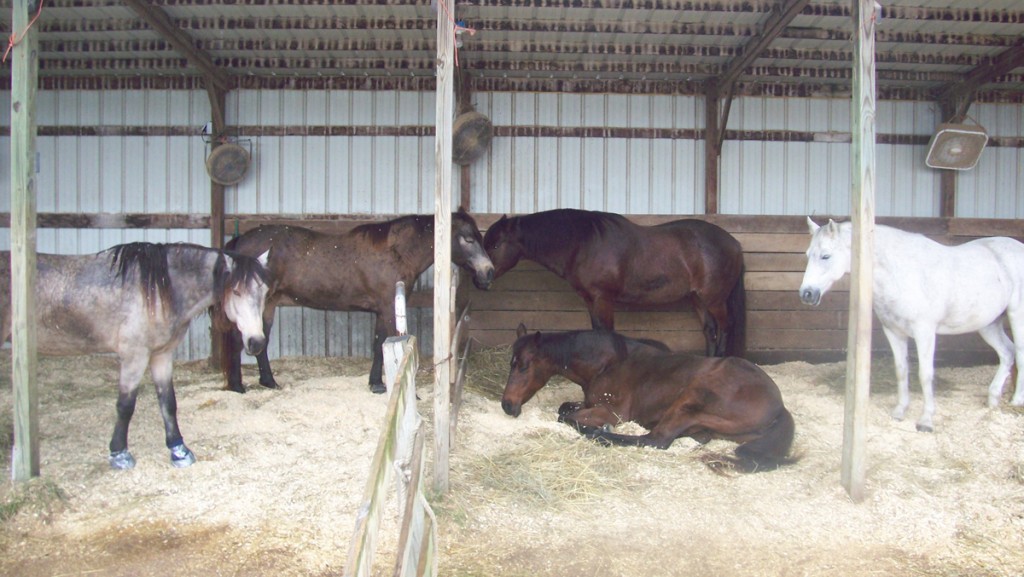Does circadian rhythm play a role in laminitis and founder in horses?

From left: Goldie, Angel, Robin, Stitches (lying down) and Kurt all hang out together. Wherever the mares were, the geldings were, too.
For years, I wondered if my second-shift schedule may have caused my horses’ laminitis and founder by messing up their circadian rhythm.
I was a journalist who worked nights and came home around 1 or 2 a.m. The horses were hungry, and I fed them when I got home. They got a handful of grain, usually because some of them needed bute, and two flakes of hay per horse.
I was more convinced of the association during Angel’s last days in May 2011, when I was spending a lot of time in the shed with her after I fed her overnight. I just sat in the shavings and hung out, looking up at the stars with her. I noticed that the boys ate a little hay and then both lied down. So, I put calories in their stomachs and then they went to bed with that sugar in their system.
In people, we know that’s a big no-no.
I’ve searched on and off since for research on a horse’s circadian rhythm to test my theory, and I have found two studies that indicate that horses actually tend to graze the most overnight when left to do whatever they want, though they also are more prone to lie down overnight than at any other time.
Over the years, my geldings probably chose to lie down in the shavings overnight because they always looked to the mares for guidance. If the mares were lying down, then they would, too. In fact, after Angel died and left the geldings alone, those two boys were so lost, they didn’t know what to do with themselves for weeks.
I now know that, if Angel hadn’t been there, they would have been off grazing, because that is what they do now. Robin Hood snorts wherever he goes. I hear him all night long. And they are on the move all night, though I limit where they can go because I don’t want them stuffing their face with grass. They tend to nap first thing in the morning.
It’s possible that the laminitic mares caused them to change their pattern of movement, leading to the boys getting fat. But, I don’t think the mares’ initial founder cases were caused by me feeding them in the middle of the night. I likely would have done more damage if I had fed them before work at 4 p.m. and then not fed them again until the next morning.
The first of the two studies I found was conducted by Cornell University in 1988. It watched a herd of eight Przewalski horses on pasture during summer around the clock and recorded their behavior. The abstract does not say how long the study lasted or where the horses were located, but I’m assuming it was New York.
The horses spent about 46.4 percent of their time feeding, .5 percent of their time drinking, 20.6 percent standing, 15.7 percent standing-resting, 1.7 percent self-grooming, 2.2 percent mutually grooming, 7.4 percent moving, 1.2 percent lying laterally and 4.1 percent lying sternally, or upright, similar to a relaxing dog. They averaged about 45 behavorial states per hour.
The study says the horses spent the greatest amount of time grazing from 8 p.m. and 4 a.m., when the temperatures were lower. They spent 68 percent of their time from 8 p.m. to midnight feeding, but only 30 percent of their time from 8 a.m to noon feeding. Recumbent rest, or lying down, was most common between midnight and 4 a.m. As it got hotter during the day, the horses spent more time standing and drinking than grazing.
The second study, by the Division of Animal Production in Australia in 2003, was a comparison of circadian patterns of sheep, cattle and horses grouped together. The abstract is brief but it notes that the horses in the study grazed extensively all night, whereas the sheep and cattle grazed more intensely during the morning and afternoon. It said horses spent only 1.1 hours lying down per day, whereas sheep and cattle spent 11.6 and 10.5 hours, respectively.